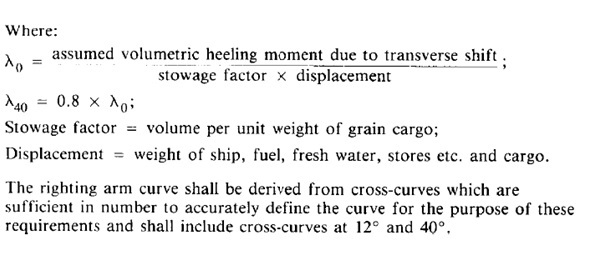The intact stability characteristics of any ship carrying bulk grain shall be shown to meet, throughout the voyage, at least the following criteria after taking into account in the manner described in part B of this Code and, the heeling moments due to grain shift:
- The angle of heel due to the shift of grain shall not be greater than 12° or in the case of ships constructed on or after 1 January 1994 the angle at which the deck edge is immersed, whichever is the lesser;
- In the statical stability diagram, the net or residual area between the heeling arm curve and the righting arm curve up to the angle of heel of maximum difference between the ordinates of the two curves, or 40° or the angle of flooding (01), whichever is the least, shall in all conditions of loading be not less than 0.075 metre-radians; and
- The initial metacentric height, after correction for the free surface effects of liquids in tanks, shall be not less than 0.30 meter.
- Before loading bulk grain the master shall, if so required by the Contracting Government of the country of the port of loading, demonstrate the ability of the ship at all stages of any voyage to comply with the stability criteria required by this section.
- After loading, the master shall ensure that the ship is upright before proceeding to sea.


Stowage of bulk grain as per grain code
All necessary and reasonable trimming shall be performed to level all free grain surfaces and to minimize the effect of grain shifting.

